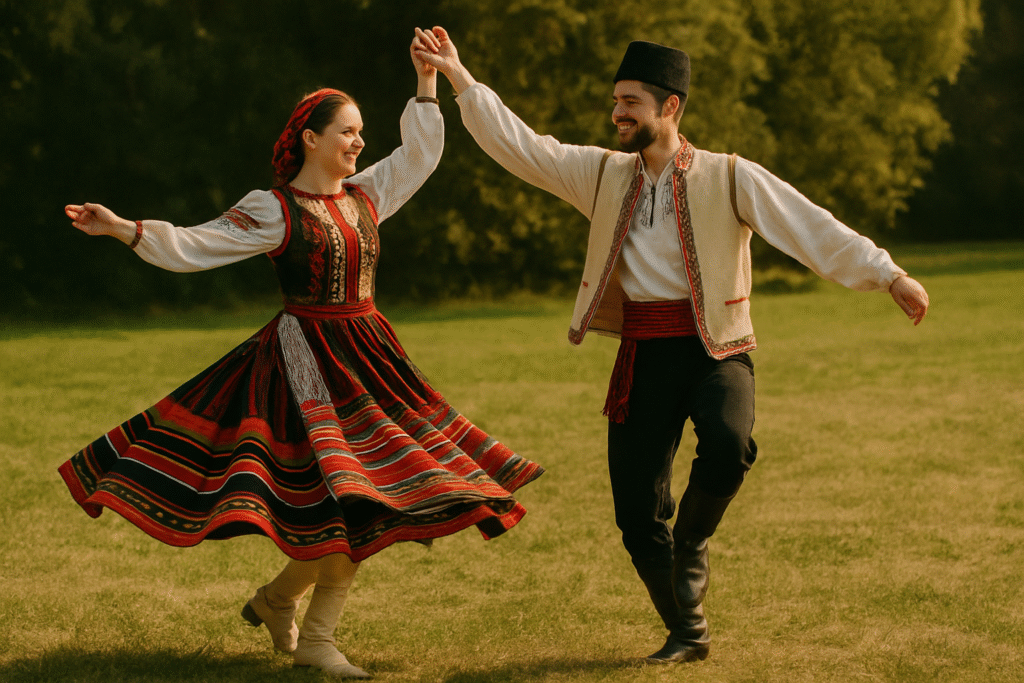
Folk dance is the heartbeat of tradition—a vivid expression of a people’s identity, history, and spirit. Unlike formal dance styles born in studios or on stage, folk dance comes from communities. Passed down through generations, it reflects everyday life, seasonal rituals, courtship traditions, and collective joy. Rooted in culture and shaped by history, folk dances are as diverse as the regions they come from—and they continue to bring people together around the world.
Whether you’re exploring folk dance as a performer, teacher, cultural enthusiast, or curious beginner, this guide will give you a rich understanding of its origins, types, movements, and enduring significance.
What Is Folk Dance?
Folk dance is a form of traditional dance that arises organically within a specific culture or community. Unlike classical or performance-based dance forms, folk dances are typically participatory, often performed at festivals, weddings, social gatherings, or seasonal events.
Each dance is tied to a region, religion, livelihood, or ritual, and its steps, music, costumes, and formations offer a window into the life of the people who created it.
While many folk dances have become stylized for the stage, their original purpose was simple: community expression, celebration, and storytelling.
The Global Language of Folk Dance
Folk dance exists in every culture around the world. While the steps and rhythms may differ, the intention is often the same: to connect people through shared movement.
Here are a few iconic folk dance traditions from around the globe:
1. European Folk Dances
- Irish Step Dance (Ireland): Known for fast footwork and rigid upper body.
- Polka (Central Europe): A lively partner dance in 2/4 time.
- Hora (Romania, Israel): A circle dance often performed at weddings.
- Flamenco (Spain): Though now seen as an art form, Flamenco’s roots lie in Andalusian folk traditions.
- Morris Dance (England): A group dance involving bells, handkerchiefs, and sticks.
2. Asian Folk Dances
- Bharatanatyam (India): A classical form that also retains elements of temple folk rituals.
- Tinikling (Philippines): A bamboo dance mimicking the movement of birds.
- Kabuki & Bon Odori (Japan): Traditional festival dances with graceful movements and colorful attire.
3. African Folk Dances
- Gahu (West Africa): A social dance featuring call-and-response rhythm and intricate footwork.
- Zulu Dance (South Africa): A ceremonial dance with powerful stamping and warrior-like energy.
4. Latin American & Caribbean Folk Dances
- Samba de Roda (Brazil): An Afro-Brazilian circle dance.
- Cueca (Chile): A flirtatious courtship dance.
- Jarabe Tapatío (Mexico): Known as the “Mexican Hat Dance,” symbolic of national pride.
5. North American Folk Dances
- Square Dance (USA): A group dance involving four couples in a square formation.
- Contra Dance (New England): A lively community dance with lines of partners.
- Powwow Dances (Native American): Cultural, spiritual, and ceremonial dances often performed in full regalia.
Common Folk Dance Characteristics
While styles vary dramatically, folk dances around the world often share these elements:
- Group Formations: Circles, lines, squares, or partner formations that emphasize unity and community.
- Repetitive Steps: Easy-to-learn patterns that can be followed by dancers of all levels.
- Live Music or Singing: Many folk dances are accompanied by traditional instruments, drums, or even vocal calls.
- Traditional Costumes: Outfits often represent local dress or historical attire, adding visual richness to the performance.
- Cultural Symbolism: Dances may represent harvest cycles, fertility, war, peace, or religious devotion.
Folk dance is not just about movement—it’s a living archive of a people’s values, challenges, and celebrations.
Why Folk Dance Still Matters
In a world where modern and commercial dance dominate mainstream stages, folk dance holds a unique and powerful place. It continues to serve as a bridge between generations, a preservation of identity, and a way for people to stay connected to their roots.
Benefits of Learning Folk Dance:
- Cultural Appreciation: Understand and honor the customs and traditions of diverse communities.
- Inclusivity: Most folk dances are accessible to all ages and skill levels—no prior experience needed.
- Community Building: Dancing in groups fosters connection, cooperation, and joy.
- Fitness: Many folk dances involve lively movement that supports cardiovascular health and coordination.
- History in Motion: Folk dance keeps stories alive—not through books, but through the body.
Folk Dance in Performance and Education
While originally performed at local gatherings, folk dances now appear on global stages, at festivals, in school programs, and cultural celebrations. Many communities form folk dance troupes to preserve and showcase their heritage. You’ll also find folkloric festivals—like the Festival of the Nations or international dance exchanges—where traditional dancers share the beauty of their cultures with new audiences.
Folk dance education is also growing in schools and community programs. Teaching these dances can foster cross-cultural understanding, promote physical activity, and build respect for diversity among students.
Getting Started with Folk Dance
Interested in joining a folk dance circle or learning more about your cultural heritage through dance? Here’s how to begin:
- Find Local Groups: Many cities have international or ethnic dance groups open to new members.
- Join Cultural Events: Attend folk festivals or cultural heritage nights to watch and learn.
- Take a Class or Workshop: Some community centers and dance schools offer folk dance instruction.
- Watch Online Videos: YouTube and educational platforms offer tutorials and performances of folk dances from around the world.
- Ask Elders or Cultural Leaders: Folk traditions often survive through oral teaching. Learning from elders is both educational and deeply meaningful.
You don’t need special shoes or gear—just an open heart and willingness to learn.
Folk dance is humanity in motion. It’s the beat of a drum in a village square, the laughter of hands joined in a circle, the stories of ancestors told through rhythm and ritual. Whether you’re dancing a Hora in a wedding circle, a jig in a festival parade, or a tribal dance on sacred ground, you are stepping into a tradition that transcends time, borders, and language.
